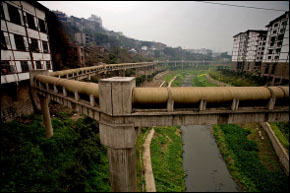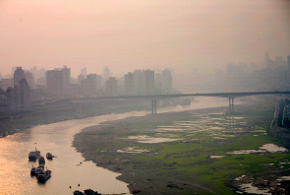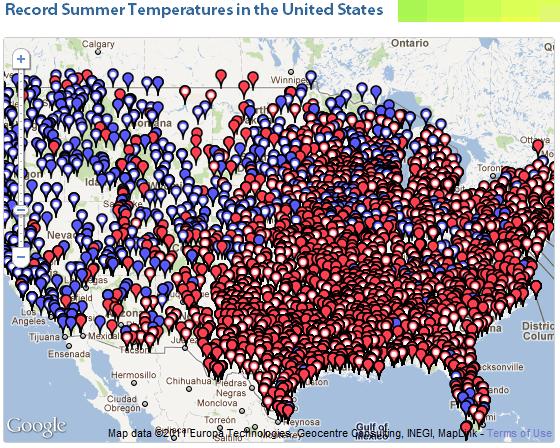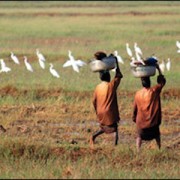Water Demand-Supply Gap Rising At Alarming Rate, Report Shows
By Andrea Hart
Circle of Blue
Global water demand will grow at an accelerated rate — from 4,500 billion meters cubed to 6,900 billion cubed — by 2030 increasing the water gap.
If water consumption continues without reform or regulation over the next 20 years, 40 percent of global demand will not be met, according to a McKinsey & Co. report released last week. More than one billion people already don’t have access to clean water.
The report warns that governments must act now to avoid severe health and economic consequences.
“There is a looming water crisis where scarcity will increase – basically the demand is outstripping supply,” said Lars Thunell, CEO of the International Finance Corporation, which, along with other organizations affiliated with the 2030 Water Resources Group, helped author the report.
Formed in 2008, the 2030 Water Resources Group is comprised of the IFC and an extended business consortium, which includes Coca-Cola Co. and the Switzerland-based Nestle SA – all of which endorsed and signed the report. Representatives from the 2030 group held a conference last week announcing the report.
McKinsey Report Key Facts and Figures
“Charting our Water Future” looks at four case studies: China, Brazil (Sao Paulo), India and South Africa. Below is each countries projected water consumption for 2030 compared to its current sustainable water supply. These figures represent what happens if consumption and water usage practices maintain the status quo.
| Country | Current Supply* | Demand in 2030* |
| China | 618 | 818 |
| Brazil | 18.7 | 20.2 |
| India | 740 | 1500 |
| South Africa | 15 | 17.7 |
| *Billions of meters cubed | ||
The study, “Charting Our Water Future,” highlights case studies in China, India, South Africa and Brazil – countries that will account for 30 percent of the world GDP and 42 percent of the global water demand by 2030, according to the report.
“One-third of the 2030 population can expect water scarcity of more than 50 percent, some can expect all the way up to 65 or 70 percent,” said Martin Stuchtey, a McKinsey consultant who gave a brief, more detailed presentation of the data at the conference.
But they key to the report, representatives said, was putting the water crisis in economic terms that open the discussion beyond just water experts, and engage all relevant stakeholders – such as politicians, farmers and businessmen.
“The exciting thing is that it (the report) not only points at the crisis, but it also points at solutions — cost curves and cost effective solutions as well as supply and demand efficiency issues,” said Thunell.
Countries like India will have to invest $6 billion a year to accommodate a growing demand and help conserve their water, said Stuchtey.
Many of the proposed location-specific solutions suggested in the report tackle inefficient water use, the speakers said.
Making water use more efficient could save millions of lives on in Africa – which is predicted to suffer some of the worst consequences from climate change and already contains some of the driest regions on the planet– according to one African water politics expert.
“Then there is the vast problem in Africa of dirty water. If you applied simple and cheap technologies like the Life Straw and SODIS, or simply getting people to boil water, in Africa you could have about 10 American football stadiums full of the children who survived who would otherwise have died,” said Dr. Paul Sullivan in an email to Circle of Blue. Sullivan is also a professor of economics at the National Defense University in Washington D.C.
During the conference and in the report, localized solutions, instead of general blanketed cures to water scarcity, were recommended. To demonstrate, the group developed a “water-marginal cost curve” per case study country to reflect where investment should go to close the gap and what long-term financial returns countries can expect.
“This study is cross-sectional examination to encourage dialogue.” said Katherine Sierra, Vice President of Sustainable Development for the World Bank, “By providing a quick snapshot, and seeing what are the most cost-effective solutions, we can create a new dialogue and new solutions.”
With respect to agricultural production, which accounts for 70 percent of global water use, first best local solutions must be implemented, said CEO of Syngenta AG, Michael Mack, who also attended the meeting. Syngenta is a Swiss agribusiness firm that genetically modifies corn and wheat to handle harsh climate conditions.
However some of the suggested improved agricultural practices, like drip irrigation, have been refuted as more water-intensive than conservational, according to other studies. A 2008 report on the Upper Rio Grande Basin featured in The Proceedings of the National Academy of Sciences, states that “that water conservation subsidies are unlikely to reduce water use under conditions that occur in many river basins.” Others, like Jeremy Berkoff, a development economist who co-authored Irrigation Water Pricing: The Gap Between Theory and Practice, argue that the impact of efficient irrigation is overstated.
What’s more some experts, in light of the removal of water from the climate agenda for Copenhagen, argue that keeping water too locally focused can leave the global crisis overlooked.
“I can’t quite understand where it’s coming from to just pull water out of the negotiating text, but maybe water is just too tangible,” said James Workman, who’s served as a water adviser to government officials, during an interview with Circle of Blue about his book, Heart of Dryness: How the Last Bushmen Can Help Us Endure the Coming Age of Permanent Drought.
Towards the end of the conference, members of the 2030 group discussed using “water as a human right” to frame debates surrounding water scarcity solutions, especially when it comes to pricing. The speakers focused on regions where there is a disconnect between usage behavior and actual water supply.
“The report should de-emotionalize the whole crisis because no one has to doubt that water is a human right.” said Peter Brabeck-Letmathe, Chairman of Nestlé S.A., “But I don’t think it’s a human right to water your car, fill up you pool, or use 20 liters for hygiene or drinking.”
Brabeck-Letmathe offered South Africa’s pricing system as a potential solution – in which households get 6,000 liters of water for free per month and are charged for using more.
But these kinds of ideas bring into question just how localized water scarcity solutions should be.
“One of the thing that’s going to vex us is jurisdiction,” Mack said, highlighting water scarcity issues in California and its impact on the entire U.S. “Is it a matter for the Californians or all of the Americans?” he added.
“What is our right to have low-cost, high-quality vegetable shipped all the way to Boston?”
Andrea Hart is the assistant news editor and a reporter for Circle of Blue. Reach her at andrea@circleofblue.org
Read the full McKinsey report here and check out other stories from Circle of Blue about the water consumption trends in the U.S.










Leave a Reply
Want to join the discussion?Feel free to contribute!